© Copyright Atlanta Coin Expositions, 2008-2025. All Rights Reserved.
Several of the links on the pages within this web site go to affiliate vendors.
A vendor affiliation can mean a small monetary compensation to the web site owner at no additional cost to you.
Several of the links on the pages within this web site go to affiliate vendors.
A vendor affiliation can mean a small monetary compensation to the web site owner at no additional cost to you.
Coin Show
Information
Shop
General
Next Monthly Coin Show
Coin Show - Monthly Notes for January 2023
Mark your calendar and join us at the next show on Sunday, February 12, 2023, in the Joe Mack Wilson ballroom.
Let's make the February coin show as busy as the January show.
As usual, dealers will showcase coins, currency, bullion, exonumia, scripophily, semi-precious stones, jewelry and other interesting items for visitors to enjoy.
The show welcomes guests to buy, sell, trade or just view the history found in the many displays. People can also bring coins and currency to the show for a free verbal appraisal based on the current market.
The show is open from 9am - 4pm, however arrive early for the most opportunities.
Should circumstances impact the show, check with this web site, the recorded show message (770-772-4359), or join our mailing list to receive up-to-date information about the next show.
Make a reminder note and visit the next Greater Atlanta Coin Show on Sunday, February 12, 2023 in the Joe Mack Wilson ballroom to join the fun and view the items on the bourse.
Let's make the February coin show as busy as the January show.
As usual, dealers will showcase coins, currency, bullion, exonumia, scripophily, semi-precious stones, jewelry and other interesting items for visitors to enjoy.
The show welcomes guests to buy, sell, trade or just view the history found in the many displays. People can also bring coins and currency to the show for a free verbal appraisal based on the current market.
The show is open from 9am - 4pm, however arrive early for the most opportunities.
Should circumstances impact the show, check with this web site, the recorded show message (770-772-4359), or join our mailing list to receive up-to-date information about the next show.
Make a reminder note and visit the next Greater Atlanta Coin Show on Sunday, February 12, 2023 in the Joe Mack Wilson ballroom to join the fun and view the items on the bourse.
1898 Quarter Dollar Coin
The January 2023 Greater Atlanta Coin Show began the new year of monthly coin shows with a slow early morning that quickly became a busy bourse with visitors filling aisles among the dealers and their displays of coins, currency, bullion and other collectibles.
We thank all of you that helped make the show a busy and interesting place to spend a few hours, whether you are a visitor, a dealer, our security or the hotel's staff. You all provide a valuable contribution to the success of the show each month. THANK YOU.
After a very cold Friday and Saturday, the weather for the Sunday show was mostly sunny with temperatures in the mid 50s, making it a nice day to visit the show.
The hotel's adjacent convention space was not that busy on Sunday, however the night before, it appeared a 50th class reunion enjoyed themselves. We could hear laughter and music from their school days. We hope they all enjoyed themselves.
We thank all of you that helped make the show a busy and interesting place to spend a few hours, whether you are a visitor, a dealer, our security or the hotel's staff. You all provide a valuable contribution to the success of the show each month. THANK YOU.
After a very cold Friday and Saturday, the weather for the Sunday show was mostly sunny with temperatures in the mid 50s, making it a nice day to visit the show.
The hotel's adjacent convention space was not that busy on Sunday, however the night before, it appeared a 50th class reunion enjoyed themselves. We could hear laughter and music from their school days. We hope they all enjoyed themselves.
The January coin show enjoyed a mix of returning guests and new visitors as well. Welcome to all, hope you enjoyed your visit and hope you will return to visit future shows.
Some of the new visitors were also new to the numismatic hobby. They expressed an interest in learning about collecting and how to approach the hobby.
The coin show is a good place to begin learning. A good reference book for both new and experienced collectors is The Official Red Book A Guide Book of United States Coins.
We also had a number of people bring coins to learn their value. This is another service of the coin show - free verbal appraisals. Some of the coins had been found in pocket change, some had been inherited. The dealers can identify which have value and which are just worth face value.
Some of the new visitors were also new to the numismatic hobby. They expressed an interest in learning about collecting and how to approach the hobby.
The coin show is a good place to begin learning. A good reference book for both new and experienced collectors is The Official Red Book A Guide Book of United States Coins.
We also had a number of people bring coins to learn their value. This is another service of the coin show - free verbal appraisals. Some of the coins had been found in pocket change, some had been inherited. The dealers can identify which have value and which are just worth face value.
Our dealers provide an abundance of experience along with the wide variety of displays from ancient to modern, from historical to current, from loose good to slabbed mint state, from coins to currency to bullion to medals to stock certificates to jewelry to other types of interesting items.
We have people asking about obtaining certification for their coins, for example, with PCGS (Professional Coin Grading Service) or NGC (Numismatic Guaranty Corporation). Representatives from those companies do not attend one-day shows, however our dealers can help determine if a collectible coin is worthy of being slabbed, otherwise known as certification.
Really nice coins can gain value by being slabbed, while others will not recover the cost of the certification process. Our dealers can help you decide whether to submit your coins to one of the companies.
In January, several of our visitors searched for coins to add to their type collections, while others wanted to find bullion.
One of the bullion dealers claimed, "The dam has broken, I can find whatever bullion you want."
But, with the current volatile markets, will that availability continue? Time will tell.
Now, let's take a look at a sampling of numismatic items.
We have people asking about obtaining certification for their coins, for example, with PCGS (Professional Coin Grading Service) or NGC (Numismatic Guaranty Corporation). Representatives from those companies do not attend one-day shows, however our dealers can help determine if a collectible coin is worthy of being slabbed, otherwise known as certification.
Really nice coins can gain value by being slabbed, while others will not recover the cost of the certification process. Our dealers can help you decide whether to submit your coins to one of the companies.
In January, several of our visitors searched for coins to add to their type collections, while others wanted to find bullion.
One of the bullion dealers claimed, "The dam has broken, I can find whatever bullion you want."
But, with the current volatile markets, will that availability continue? Time will tell.
Now, let's take a look at a sampling of numismatic items.
1812 Large Date One Cent Coin
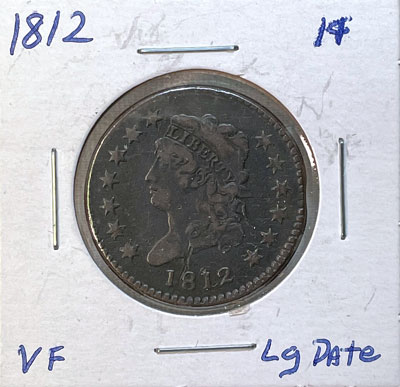
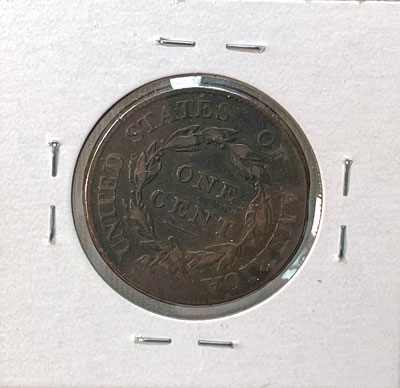
Our first specimen is an 1812 Large Date One Cent Coin.
At over 210 years old, this is a nice circulated coin.
Per The Red Book, the Classic Head Large Cent Coins from 1808-1814 contained a softer copper than earlier or later large cent coins.
The metallic impurities in the coins made them wear faster. Today, the coins can be difficult to find in the better conditions.
In 1812, the US Mint produced just over one million of the large cents. Their total production included some with a large date like this coin and others with a small date.
PCGS CoinFacts estimates 3000 of the 1812 large cent coins survived through the years with most of those being brown. They estimate only a few have Red Brown characteristics with none surviving as a Red copper coin.
At over 210 years old, this is a nice circulated coin.
Per The Red Book, the Classic Head Large Cent Coins from 1808-1814 contained a softer copper than earlier or later large cent coins.
The metallic impurities in the coins made them wear faster. Today, the coins can be difficult to find in the better conditions.
In 1812, the US Mint produced just over one million of the large cents. Their total production included some with a large date like this coin and others with a small date.
PCGS CoinFacts estimates 3000 of the 1812 large cent coins survived through the years with most of those being brown. They estimate only a few have Red Brown characteristics with none surviving as a Red copper coin.
How does one decide if the 1812 large cent coin is a large or small date?
Per PCGS, look at the numeral "8." The small date "8" has a bottom loop that is almost twice the size as the top loop. In the large date "8" the two loops are roughly equal in size.
As a 210+ year old coin, this is a nice example with "LIBERTY" clearly visible across her cap, her ear clearly defined and lines in her hair.
This coin would make a nice addition to a large cent collection or as a building block to a new collection.
Per PCGS, look at the numeral "8." The small date "8" has a bottom loop that is almost twice the size as the top loop. In the large date "8" the two loops are roughly equal in size.
As a 210+ year old coin, this is a nice example with "LIBERTY" clearly visible across her cap, her ear clearly defined and lines in her hair.
This coin would make a nice addition to a large cent collection or as a building block to a new collection.
1851-O Ten Cent Coin
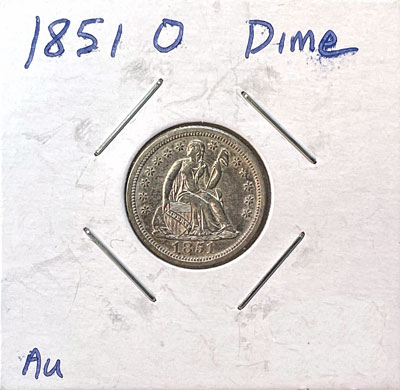
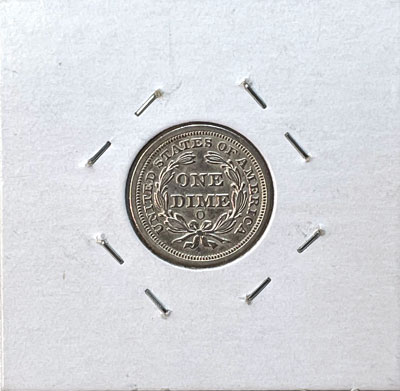
The next coin is an 1851 Liberty Seated Ten Cent Coin struck at the US Mint's New Orleans location.
The Liberty Seated Ten Cent Coin began in 1837 and continued through 1891. During the first years only Philadelphia and New Orleans produced the coins with San Francisco and Carson City adding to the production in the later years.
Throughout the Liberty Seated Dime years, the Mint produced several varieties.
From 1838-1853, the Liberty Seated design added stars to the obverse.
In 1851, New Orleans struck 400,000 of the Liberty Seated Dimes.
The Liberty Seated Ten Cent Coin began in 1837 and continued through 1891. During the first years only Philadelphia and New Orleans produced the coins with San Francisco and Carson City adding to the production in the later years.
Throughout the Liberty Seated Dime years, the Mint produced several varieties.
From 1838-1853, the Liberty Seated design added stars to the obverse.
In 1851, New Orleans struck 400,000 of the Liberty Seated Dimes.
Today, PCGS estimates the survival rate at 250 of the silver 1851-O dimes.
They comment that with the New Orleans Mint being so far from collectors in the 19th century, not many of the Liberty Seated 1851-O Ten-Cent coins survived in the higher grades.
This coin shows off its 90% silver 10% copper content and weighs in at 2.67 grams just before Congress changed the weight to 2.49 grams in 1853.
At over 170 years old, this is a vibrant example of the silver Liberty Seated 1851-O Ten-Cent coin.
It would make a nice addition to a dime collection or to a silver coin collection, though it is worth much more than its silver content.
They comment that with the New Orleans Mint being so far from collectors in the 19th century, not many of the Liberty Seated 1851-O Ten-Cent coins survived in the higher grades.
This coin shows off its 90% silver 10% copper content and weighs in at 2.67 grams just before Congress changed the weight to 2.49 grams in 1853.
At over 170 years old, this is a vibrant example of the silver Liberty Seated 1851-O Ten-Cent coin.
It would make a nice addition to a dime collection or to a silver coin collection, though it is worth much more than its silver content.
1856 One Cent Coin
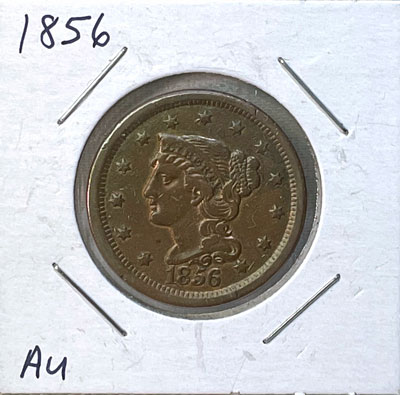
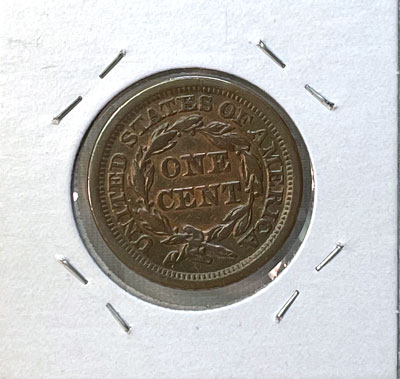
Our next coin is another large cent, though this one is of the Liberty Head design from 1816-1857.
Oddly, in reviewing the Liberty Head Large Cent coin in The Red Book, several pages show many elements to check for the different coin strikes through the production years.
Some elements of interest include overstrikes, lettering sizes, large and small dates, large and small stars among other things.
Interestingly, PCGS classifies these coins as the Coronet Head from 1816-1839 and the Braided Head from 1839-1857.
Using that designation, our 1856 Liberty Head Large Cent Coin is one of the Braided Head designs.
The later Braided design included a braid across her forehead and beads holding her bun on the back.
Oddly, in reviewing the Liberty Head Large Cent coin in The Red Book, several pages show many elements to check for the different coin strikes through the production years.
Some elements of interest include overstrikes, lettering sizes, large and small dates, large and small stars among other things.
Interestingly, PCGS classifies these coins as the Coronet Head from 1816-1839 and the Braided Head from 1839-1857.
Using that designation, our 1856 Liberty Head Large Cent Coin is one of the Braided Head designs.
The later Braided design included a braid across her forehead and beads holding her bun on the back.
In 1856, the Philadelphia Mint produced just under 2.7 million of the large cent coins in two varieties.
One variety included a forward slanted "5" whereas the other contained a straight "5" in the date.
Our coin appears to be of the slanted "5" variety.
PCGS estimates 5000 of the upright "5" and 6000 of the slanted "5" have survived.
Considering the Mint did not maintain production records of the two varieties, it's unclear how the survival rate difference was calculated.
They do comment that the two types generally retain the same value across the different grades from Good to the Mint State levels.
Though worn, this is another nice specimen to add to a collection.
One variety included a forward slanted "5" whereas the other contained a straight "5" in the date.
Our coin appears to be of the slanted "5" variety.
PCGS estimates 5000 of the upright "5" and 6000 of the slanted "5" have survived.
Considering the Mint did not maintain production records of the two varieties, it's unclear how the survival rate difference was calculated.
They do comment that the two types generally retain the same value across the different grades from Good to the Mint State levels.
Though worn, this is another nice specimen to add to a collection.
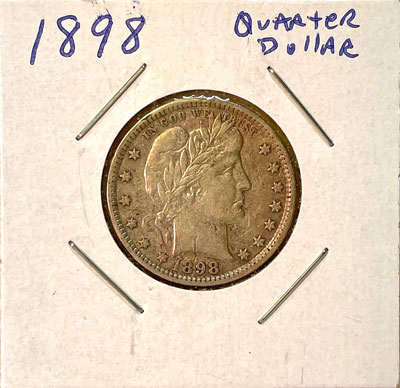
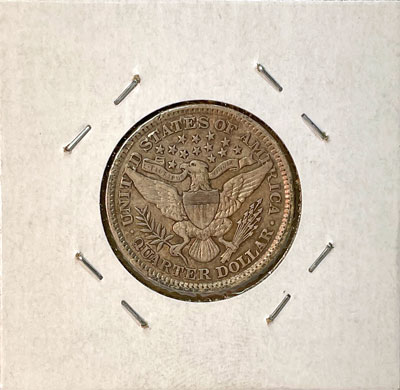
Our last example for this month is a silver 1898 Barber Quarter Dollar Coin.
The US Mint produced the Liberty Head or Barber, for designer Charles E. Barber, Quarter Dollar Coin from 1892-1916.
The previous design was the Liberty Seated quarter while the next design was the Standing Liberty quarter.
In 1898, the year of our coin, the Philadelphia Mint struck 11.1 million of the quarter dollar coins while the New Orleans and San Francisco Mint locations produced significantly less.
PCGS estimates of the 11.1 million Philadelphia produced quarters, roughly 13,500 survive across all grades today.
The US Mint produced the Liberty Head or Barber, for designer Charles E. Barber, Quarter Dollar Coin from 1892-1916.
The previous design was the Liberty Seated quarter while the next design was the Standing Liberty quarter.
In 1898, the year of our coin, the Philadelphia Mint struck 11.1 million of the quarter dollar coins while the New Orleans and San Francisco Mint locations produced significantly less.
PCGS estimates of the 11.1 million Philadelphia produced quarters, roughly 13,500 survive across all grades today.
Furthermore, they claim, "The 1898 Quarter Dollar is a great date among the Barber series. It is common, it often comes nice, and there are ample supplies of Mint State examples in a variety of grades."
Though definitely circulated, this coin has a bold "LIBERTY" and a distinct ribbon across her crown making this a desirable coin to own.
With a magnifier, collectors can find Mr. Barber's initial "B" in the truncation of Liberty's neck just above the "1" in the date.
Several numismatists specialize in Barber coins. This one would be a nice addition to a Barber collection or to a quarter dollar collection.
Though definitely circulated, this coin has a bold "LIBERTY" and a distinct ribbon across her crown making this a desirable coin to own.
With a magnifier, collectors can find Mr. Barber's initial "B" in the truncation of Liberty's neck just above the "1" in the date.
Several numismatists specialize in Barber coins. This one would be a nice addition to a Barber collection or to a quarter dollar collection.
